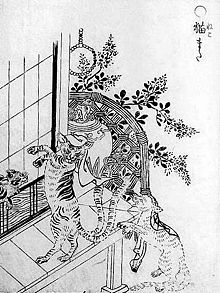Nekomata

Nekomata (jap. 猫股 or 猫又; meaning ‘forked cat’) is the name of a fictitious being from japanese mythology. It is said to be a lower form of a bakeneko (a high ranged cat-demon).
Description
Japanese folklore says that Nekomata just look like a domestic cat, but they have two tails instead of just one. They are also able to walk upright on two legs like humans, but only when unobserved. Nekomata are furthermore said to morph into demons when angry.
Traditions
First stories about alleged encounters with nekomata occur during the early 17th century of Japan. In the book Yamato Kaiiki (大和怪異記, engl. „Mysterious stories from Japan“), written by an unknown author in 1708, a story speaks about a haunted house of an rich samurai. The inhabitants of this house witness several poltergeist-activities and the samurai invites countless shamans, priests and evokers in attempt to make the happenings come to an end. But none of them is able to find the source of the terror. One day one of the most loyal servants observe the very old cat of his master carrying a shikigami with the imprinted name of his lord in its mouth. Immediately the servant fires an sacred arrow, hitting the cat in its head. When the cat is lying dead on the floor, all inhabitants can see that the cat has two tails and therefore has been a nekomata. With the death of the demon-cat the poltergeist-activities end. Similar eerie stories about encounters with nekomata appear in books such as Taihei Hyakumonogatari (太平百物語, engl. „Collection of 100 fairy tales“), written by Yusuke (祐佐, or Yūsa) in 1723 and in the book Rōō Chabanashi (老媼茶話, „Tea-time gossip of old ladies“), written by Misaka Daiyata (三坂大彌) in 1742.
Nekomata in modern subculture
Nekomata are popular motivs in manga and anime today. A well known fictitious Nekomata of modern times is "Kirara" from the novel and anime-series Inuyasha (written by Takahashi Rumiko). Kirara appears there as a cuddly little kitten with two tails when calm, but she rapidly morphs into a giant, flying saber-toothed tiger, when provoked or when ever her mistress 'Sangō' orders the cat to do so.
Sources
- Patrick Drazen: A Gathering of Spirits: Japan's Ghost Story Tradition: from Folklore and Kabuki to Anime and Manga. iUniverse, New York 2011, ISBN 1462029426, page 114.
- Elli Kohen: World history and myths of cats. Edwin Mellen Press, Lewiston 2003, ISBN 0773467785, page 48–51.
- Carl Van Vechten: The Tiger In The House. Kessinger Publishing, Whitefish 2004 (Reprint), ISBN 1417967447, page 96.
External links
- web-informations about Nekomata at obakemono.com (english)
- Nekomata – The Split-Tailed Cat at hyakumonogatari.com(english)
